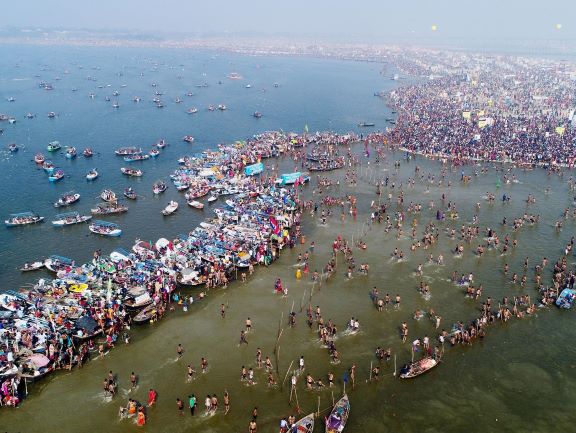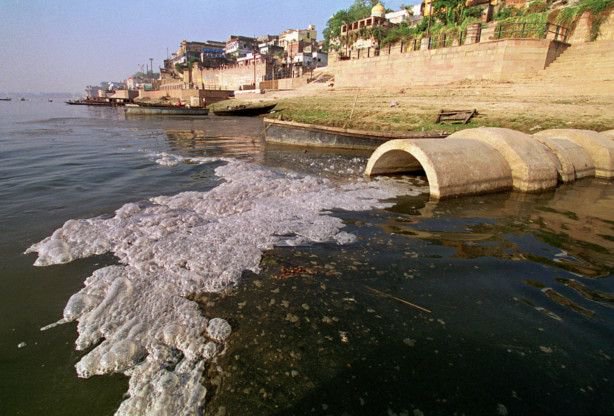Allahabad On Verge of ‘Epidemic’ After Kumbh Mela: NGT
 Holy waters in danger
Holy waters in danger
The National Green Tribunal rang alarm bells on 22 April about Allahabad saying that it could be on a verge of ‘epidemic’. The green bench quoted chief secretary of UP saying 60,000 metric tonnes or MT of solid waste has been collected at the Baswar Solid waste treatment plant and is yet to be treated. Out of which 18,000 MT of waste was generated during Kumbh which lies at the Baswar plant that has been non-operational since last September. The chief secretary is asked to appear before NGT on 26 April over the poor waste management during the months-long religious gathering on the banks of Ganga.
The Green court has raised flags as it predicts a sudden spike in acute diarrhoea, enteric fever, viral hepatitis and cholera in the coming summer months. It said that this needs to be fixed soon to avert any epidemic in the near future.
The Tribunal brought attention to the polluted groundwater as well. “Dirty water from toilets was being collected in kutcha pits. The base of the soak pits had not been lined and the dirty water could percolate underground,” says the order.
Holy Ganga in Lurch
The order clearly states the Ganga was left in a lurch. “The committee found that a large number of toilets were constructed in camps on the Arail side, very close to the river. Rajapur Sewage Treatment Plant (STP) received excess sewage than the installed capacity. Only 50 percent of Rajapur drain was being treated through geo-tube (it extracts solid waste from the waste going in the drain so that only water enters it) and the remaining 50 percent was being permitted to enter Ganga without treatment,” read the NGT order.
Regarding another STP at Salori, the NGT said it too was not working satisfactorily. “It had more sewage than it could treat. The geo-tube was not working satisfactorily and 50 percent of the sewage from the drain was trapped and the rest was going into the Ganga,” the tribunal said in the order.
Failure of Geotube technology
The NGT also came down heavily on the administration over the geo-tube technology. “The Mawaiya Nala, where the technology has been adopted, had a bypass because of which untreated water from the drain entered Ganga. The committee also found that there existed a big dirty water pond at Parmarth Niketan Arail and human excreta was seen floating in it,” read the order.
Mansuthia, another drain, presented a similar picture to the committee. It too had a bypass, due to which untreated waste met treated waste just before it flowed into the Ganga. “Creation of bypass at places where geo-tube technology had been adopted has let dirty water enter the river,” the NGT order read.
The committee found several other violations of NGT orders for preserving any river. Calling it the grossest violation NGT’s earlier orders, the order said, “Thirty-six temporary ponds at the bank of the river were constructed with no lining and some of them still contain dirty water.”
The order scathingly criticized the Mela administration for being non-cooperative with the supervisory committee in several matters, including uninstallation of public toilets built right on the banks of the Ganga. “Pucca constructions were being raised at Yamuna bank and despite notice, the authorities did not disclose as to who had sanctioned the maps/building plans,” the order cited. It added that the administration was trying to “hoodwink the cleaning of waste from the soak pits and septic tanks and ponds.”
History Repeats
This is not the first Kumbh to have come under criticism for poor management. Things were far from perfect during the last Kumbh as well. The Comptroller and Auditor General (CAG) of India’s audit report of the event read, “No effective planning for the protection of environment and pollution control was made for the Maha Kumbh Mela.”
In 2013, at the last Kumbh Mela too there was an issue of solid waste management. More than 25,000 tonnes of solid waste generated during the festival went unmanaged and was found choking the river and city drains.
Picture credit: Kumbh.gov.in










